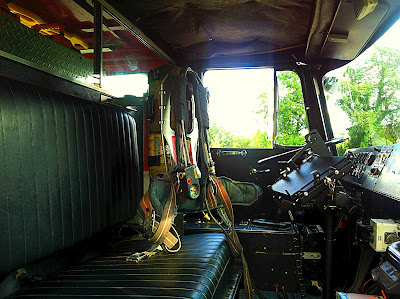Many people cherish is the memory
of their first car. Some people are
lucky enough to have their first car be considered a “classic” or “collector”
car. Here at BFR we are lucky enough to
still have one of our first fire trucks!
Engine 5 is a 1986 Pirsch Pumper
equipped with a 750 gallon water tank and a 1500 gallon per minute pump. Engine 5 was one of three fire apparatus
purchased by the city in 1986 for the newly formed Brentwood Fire
Department. Back then, Engine 5 was
called Engine 510. The other two
apparatus purchased were a 1650 gallon tanker truck (Tanker 1) and another
identical Pirsch Pumper, Engine 520.
These twin pumpers had a rather interesting journey to Brentwood in
1986.
Just as the new fire department was awaiting
delivery, Pirsch announced that it would be filing bankruptcy. Fearful of not receiving its apparatus as
promised, Chief Filer and another firefighter flew up to the Peter Pirsch and
Sons factory in Wisconsin to lay claim to their apparatus. Rumor has it they drove them off the line and
back to Brentwood with the paint still tacky.
This was apparently a wise move, as Pirsch cut their deliveries short
that year and many orders went unfulfilled.
Pirsch officially ceased all operations in 1987.
Brand new Engine 5 at the first BFD Station 1
located near the intersection of Church St and Wilson Pike
Two BFD Captains equip brand new Engine 5 with the tools they need to
keep the city safe
Engine 5 at the current Station 1 in the early 90s
Engine 5 is currently based out of Station 4. While Engine 5 was taken off frontline service
in 1997 it can still be called upon as a reserve apparatus if other engines are
out for service or repair, though there is another reserve apparatus in line
ahead of it.
Engine 5 is also an excellent training tool. Most pump panels today use electronic
controls to open and close valves and adjust pressures. Engine 5 uses all manual controls and gauges
to give an engineer in training a better “feel” for pump operation. Mastering the operation of this panel makes
operating all the other apparatus much easier.
A Haligan and two pry bars are mounted on the
outside of E5 for easy access. Modern fire engines are wonders of design and
layout; Engine 5 is a bit more utilitarian in nature.
BFR’s newest fire engine has internal ladder storage, but Engine 5
stows its ladders on the side. Many newer engines have powered ladder racks
that bring the ladders down to make them easier to remove and stow, but this
Pirsch keeps it simple.
The deck gun is another piece of equipment that is still installed on
all of BFR’s apparatus today. The deck
gun allows a large amount of water to be sprayed onto a fire in a short amount
of time.
One very unique aspect about Engine 5 is that
the rear seats are in an open cab formation.
This allowed firefighters to easily exit the apparatus but also meant
that they were partially exposed to the elements. The yellow bar in front of the seat is called
a Man Saver. This bar is a one way
barrier that keeps a firefighter from falling out of the apparatus. To exit the seat a firefighter simply folds the
bar up towards the roof or back towards the seat. Remember, when this engine first came into
service, it was acceptable for firefighters to ride on the back! The Man Saver
bars weren’t added until approximately 2010.
A view inside the cab reveals a much simpler
design than current fire apparatus. The
air pack seen here is mounted so that the officer can easily put it on before
leaving the apparatus
Engine 5 is a cab over design, meaning that the driver sits ahead of
the front wheel and over part of the engine.
This allows better visibility and increased maneuverability, two aspects
that are very important when driving a fire truck to an emergency scene. Firefighters often call this a “custom cab”
configuration. Every current BFR fire apparatus except Brush 1 and the command
vehicles utilize the custom cab design.
Engine 5 not only serves as a great training resource and capable response
apparatus, it reminds BFR personnel of where the department started and how far
firefighting technology has come. If you
are ever at Fire Station #4, be sure to check out this piece of departmental
history.











